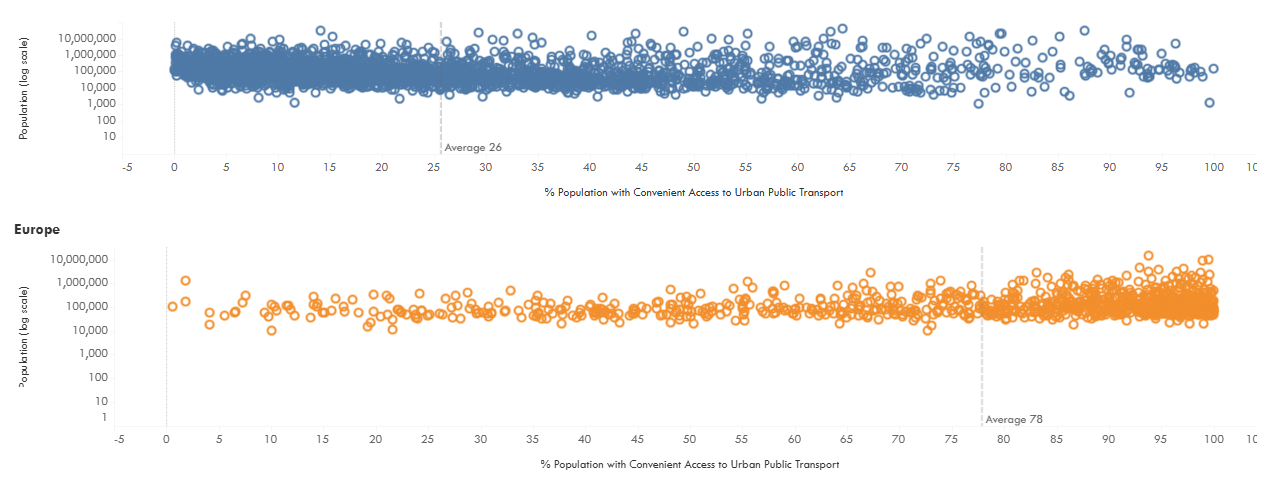Asia and the Pacific is a global leader in electric mobility and energy-efficient transport, with significant progress in railway electrification and emissions reduction. However, these advancements remain untracked in relation to the Sustainable Development Goals. These charts illustrate why that matters.
Despite decades of recognizing the crucial role of transport in sustainable development, the 2015 Sustainable Development Goals (SDGs) failed to include a dedicated goal for the transport sector. Instead, transport was relegated to a supporting role, merely facilitating the achievement of the seventeen goals.
The upcoming UN Decade of Sustainable Transport (2026-2036) aims to rectify this omission. However, a crucial piece of the puzzle remains missing – nobody is tracking SDG progress specifically from the transport sector’s perspective.
Our analysis of over 20 indicators aims to fill this gap for Asia and the Pacific.
We found that the region has started shifting towards electric mobility, supported by increasingly robust policies. Asia is a global leader in electric mobility transition, with more than 90% of the global e-vehicles registered.
The region stands out as a leader in energy efficient transport. For a unit of economic output, the transport sector consumes the least energy globally. More importantly, this trend is improving.
The transport sector has made significant strides since 2015, achieving an average annual reduction in energy intensity of 6% and consistently demonstrating lower transport energy intensity (energy consumption per unit of GDP) than other regions.
To generate one US dollar of GDP, Europe and North America’s transport sectors—on average—consume twice as much energy.
Railways in Asia and the Pacific have made significant contributions to the SDGs. Their carbon emissions grew by just 2% annually from 2000 to 2010 and decreased by 0.2% annually between 2010 and 2022. This is especially impressive considering the substantial expansion of railway infrastructure during this period.
A critical factor in this achievement is the growth in railway electrification, with 56% of tracks now electrified compared to 34% in 2000. The People’s Republic of China and India are now global leaders in railway electrification.
The region has made notable progress in decreasing transport fossil fuel subsidies (SDG 12.c), shrinking the transport sector’s share of total fossil fuel subsidies from 22% in 2014 to 14% in 2022.
https://flo.uri.sh/visualisation/20692646/embed
However, transport progress lags that of other regions. Asia and the Pacific’s share of total transport fossil fuel subsidies grew from 32% to 44% between 2010-2015 and 2015-2022.
Experts estimate that transport fossil fuel subsidies in the region range from $100 billion to $500 billion, depending upon what gets counted. If only the underpricing of fuel is considered, it is $100 billion, and when environmental, road crash, and congestion costs of underpricing fuel are measured, it is $500 billion.
Per the SDG’s target 3.6, Asia and the Pacific must halve the number of deaths and injuries from road traffic accidents by 2030. However, instead of taking bold strides, it has taken baby steps.
The average annual reduction in fatalities decreased from 1.4% between 2010-2016 to 0.6% between 2016-2021. Despite the baby steps, there’s a silver lining: two-thirds of countries in the region have managed to decrease road crash fatalities.
The region has made progress in reducing vehicle tailpipe emissions. But it’s a case of one step forward, two steps back.
Historically, road transport has been a disproportionately large contributor to air pollution. However, we partially solved that challenge by adopting stricter vehicle emissions and fuel quality standards, especially in the more advanced economies.
We now see a 2% annual regional decrease in harmful pollutants from road vehicles’ tailpipes like PM2.5, sulfur oxides, and black carbon. Unfortunately, rising emissions from domestic shipping counter this progress and limit transport’s overall progress towards relevant SDGs such as SDG 3.9 (reduce deaths and illnesses from pollution) and SDG 11.6 (reduce environmental impacts of cities).
The SDGs consider living within 500 meters of bus stops or 1 kilometer from high-capacity systems like metro lines as a gold standard indicator of public transport access. However, Asian cities score abysmal urban access ratings.
Out of more than three thousand urban centers, the average for convenient public transport access is only 26%. In comparison, the global average is 36%, while more than three-quarters (78%) of residents in European urban centers, on average, have convenient access to public transport. This equates to 1.4 billion urban population in Asia and the Pacific failing to meet SDG 11.2.1 for urban access.
The transport sector in Asia and the Pacific is alarmingly off-track in meeting its fair share of the Paris Agreement commitments. A 6.6% surge in CO2 emissions in 2023 puts the region’s emissions at par with the combined emissions of Europe and North America.
Since implementing the SDGs, Asia’s transport sector has contributed to 83% of the global transport sector increase and is region’s second fastest-growing source of emissions after the power sector.
Its transport infrastructure is highly vulnerable to natural hazards, with annual damages estimated at $10 to $50 billion. These direct damages cost 7% of the region’s transport sector investments.
Despite this, climate resilience and adaptation remain under-prioritized and under-invested. While long-term data is scarce, the evidence is clear. For instance, only 4% of transport sector targets in nationally determined contributions of low and middle-income Asian countries address adaptation, and a mere 0.13% of climate finance in Asia supports it.
A significant gap exists between climate funding and priorities. Although the transport sector contributes 12% of the region’s emissions, it receives only 7% of the total financing of multilateral climate change funds (since 2003).
Shockingly, only 1% of this funding has trickled down to low-income countries, leaving them struggling to meet their transport sector climate goals. Funding for transport projects has doubled since 2015, but other areas like forestry, industry, and energy have seen even more significant increases.
The incoming UN Decade of Sustainable Transport provides a unique opportunity to increase focus in critical areas of transport and ramp up efforts to deliver on the fundamental role transport plays in economic and social development. Providing a global agenda on sustainable transport can raise the sector’s profile, unlock finance, and result in improved actions that benefit everyone.
Sudhir Gota, Co-Team Lead, Asian Transport Outlook, contributed to this article.
Source: ADB Blog





